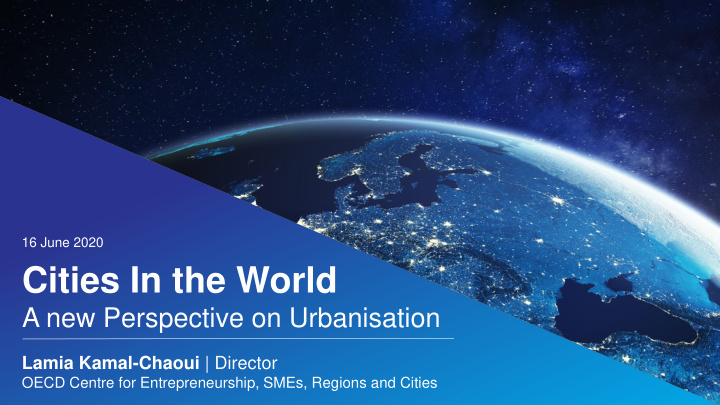



@OECD_local #ChampionMayors 16 June 2020 Cities In the World A new Perspective on Urbanisation Lamia Kamal-Chaoui | Director OECD Centre for Entrepreneurship, SMEs, Regions and Cities
Harmonised definitions shed new light on urbanisation • Two consistent, global definitions of cities and metropolitan areas • Fills a void: no consistent existing global definitions
Where do people live? • City populations have doubled over the last 40 years and will increase from 48% to 55% of the world’s population by 2050 .
What does the future hold for city and rural populations? City populations are projected to grow from 3.5 billion in 2015 to 5 billion in 2050. Population (billions), 1975-2050 5 billion 5.0 +40% 4.5 4.0 3.5 billion 3.5 3.0 2.5 2.0 1.5 1.0 0.5 0.0 1975 1980 1985 1990 1995 2000 2005 2010 2015 2020 2025 2030 2035 2040 2045 2050 Cities Towns & semi-dense areas Rural areas
Focus of Cities of the World report 1. Determines which metropolitan areas grew and declined , and why. 2. Examines how the urban system changes with economic development. 3. Analyses differences in quality of life across different areas. 4. Assesses the changing shape of cities and its impact on service delivery and sustainable development.
Metropolitan Growth
Large metropolitan areas grow fastest Annual growth - metropolitan areas (2000 – 2015) Population growth is Growth - metropolitan areas increasingly concentrated 2.0% in large metropolitans. 1.5% This exacerbates challenges for: • 1.0% transport provision • affordable housing 0.5% • pollution 0.0% 50k-250k 250k-1mil 1mil-5mil 5mil+
One-fifth of metropolitan areas in the world are shrinking Currently 20% decline since 2005 Looking forward 30% decline by 2050
Development & Urban systems
More metropolitan population in richer countries Share of metropolitan population 70% 60% 50% 40% 30% Countries with higher GDP per 20% capita have larger proportions of the 10% population living in 0% metropolitan areas. Low-income countries Lower-middle countries Upper-middle countries High-income countries population < 250K 250K < population < 1M 1M < population < 5M 5M < population
Urbanisation is linked to regional economic disparities Metropolitan structure matters for within-country regional disparities: • Regions with larger metropolitan areas tend to be richer. • Regional income disparities are greater in middle-income countries than in the poorest and the richest countries.
Life in Cities
Cities offer the highest quality of life Well-being Rural areas Towns and semi-dense areas Cities 19% • Evidence from 111 countries shows that city residents are more satisfied with their 17% lives . 16% • This trend explains why people continue to be attracted by cities, driving urbanisation . % satisfied with life
What explains the differences in quality of life? Residents in cities enjoy Health-problems Digitalisation better living conditions: Rural areas Towns and semi-dense areas Cities Rural areas Towns and semi-dense areas Cities 85% 31% 28% 82% 25% • Fewer health problems, 76% better access to services (digitalisation) % with recent internet use % with health problems But cities also face: Air quality Insecurity • More crime and violence, Rural areas Towns and semi-dense areas Cities Rural areas Towns and semi-dense areas Cities urban ills (air pollution, 20% 79% 75% obesity, stress) 16% 63% 15% % satisfied with air quality % victims of theft
Shape of cities and sustainable development
How do cities grow? Decomposing average annual population growth in cities, 1975-2015 Densification Expansion • Globally, cities have 29% continuously become 35% 36% denser over the past 40 years. • Policy-makers need to 71% 65% 64% accompany the increasing population density with better access to services and affordable housing . 1975-1990 1990-2000 2000-2015
The growth & increasing density of cities raise serious challenges Average population growth in areas at risk of floods, 2000-15 2.5% 2.0% • The growth and 1.5% increasing density of cities raises their 1.0% exposure to climate change risks. 0.5% • In cities, risks associated 0.0% Cities Towns and Semi-dense Rural areas with sea-level rise has Areas been increasing. 0-5 m above sea level not at risk
The way forward
Implications for future OECD work Key instrument for urban OECD and EC setting a policy and SDG new benchmark for monitoring: better data sub-national statistics for better lives Important topics for Shrinking cities & managing decline smartly future work : Managing urbanisation with sustainable development Specific challenges of intermediary cities Digital and physical infrastructure investment needs in rural areas
VISIT OUR NEW REGIONAL STATISTICS HUB www.oecd.org/regional/regional-statistics/ VISIT OUR NEW REGIONAL STATISTICS HUB www.oecd.org/regional/regional-statistics/
THANK YOU Lamia.KAMAL-CHAOUI@oecd.org | Twitter: @lamia_k_c Website: www.oecd.org/cfe/ | Twitter: @OECD_local | LinkedIn: linkedin.com/company/oecd-local
Recommend
More recommend